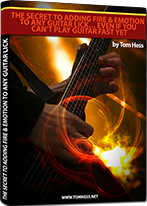Lead Guitar Solo Lesson – Phrasing Over The Barline
by Tom Hess
Emotion To Any Guitar Lick

EMAIL TO GET ACCESS
By submitting your info, you agree to send it to Tom Hess Music Corporation who will process and use it according to their privacy policy.
Want a simple way to make any lead guitar solo more creative?
No problem.
Here it is:
Instead of making every lead guitar lick fit into 1 measure …
… make some lead guitar licks last longer, so they stretch over the barline.
(A barline is a line dividing 2 measures in a piece of music.)
And even though this sounds quite advanced - it's not.
Emotion To Any Guitar Lick

EMAIL TO GET ACCESS
By submitting your info, you agree to send it to Tom Hess Music Corporation who will process and use it according to their privacy policy.
This is an easy way to make your playing sound different from what you might normally play.
Not to mention...
...it makes your playing instantly stand out from most other guitar players.)
What does playing a lead guitar solo over the barline mean and how do you do it?
Check out this video where I show it to you in detail:
Now that you know how to play a lead guitar solo lick over the bar …
… want to know other ways to make your lead guitar playing more creative and stand out from other guitar players?
Here are 3 of my favorites techniques for doing just that:
Lead Guitar Solo Phrasing Technique #1: Modulating Pitch Function
Modulating pitch function (the term I created back in 1994 to describe the concept below) happens when you hold out the same note over two (or more) chords in a song or backing track.
For example:
Let’s say you are performing a lead guitar solo over the chords C major 7 - E minor - A minor add 9 and G7.
These chords all have 1 note in common: note B.
C major 7 has notes C E G B.
E minor has notes E G B
A minor add 9 has notes A C E B
G7 chord has notes G B D F.
If you hold the note out over all 4 chords, it would sound and feel different over each one.
That’s because B is the 7th of the C major 7 chord, the 5th of the E minor chord, the 9th of the A minor add 9 chord and the 3rd of the G7 chord.
And each of these functions sounds nothing like the others.
Watch this video to see and hear this concept in action:
Note: many singers use modulating pitch function to create awesome vocal melodies. They do it by holding out a single note over changing chords in the song.
You can do the same on lead guitar.
It’s one of many lead guitar solo mastery tools you can pick up from studying great singers:

There are 2 great ways to practice modulating pitch function to play more creative lead guitar solo licks:
Idea 1: Create a chord progression where chords have one or more note in common. Then use your lead guitar improvisation skills to play over it – holding out common tones over chords as they go by.
This means you have to think in advance about what the common tones are.
And then create lead guitar solo licks that emphasize those common tones.
Idea #2: Record (or find online) a static drone. A drone is just a single pitch you sustain for a long time.
For example: imagine hitting the low E string and sustaining it for 5 minutes.
Next, improvise chords over the drone.
Chords can be anything you want and they don’t even have to be in any key.
But every chord you play needs to have the drone as one of its notes.
(The root, 3rd ,5th, 7th, 9th, 11th or 13th.)
This exercise can keep you busy for weeks.
The better your knowledge of music theory, fretboard visualization and ear training – the more fun you’ll have with this idea.
At the same time, it doesn't matter how advanced you are. You can find many ways to challenge yourself with this drill. For example:
- play the chords to a metronome and gradually increase the tempo (this will force your brain to think faster).
- restrict yourself to a certain area of the fretboard (to challenge your fretboard visualization).
- restrict yourself to a certain set of strings.
- restrict yourself to a certain voice leading (for example: the drone note in the chord must always be the highest sounding pitch).
(And of course, you can do more than one of these restrictions at the same time.)
All this will challenge your musical brain and make you a more creative musician.
Question: Tom Hess, What Do You Mean By “Improvise Chords”? I Thought Improvising Was All About Playing Melodies In A Lead Guitar Solo?
Answer: No, not at all. Improvising simply means to create something spontaneously.
When most lead guitar players talk about improvising, they are talking about improvising using melody.
But what I described above is “improvising with chords”. Meaning: you make up chord progressions on the spot. Same way you’d make up a lead guitar solo on the spot.
Question: “Tom Hess, What If I’m A Beginner With Music Theory? This Seems Really Hard! What Should I Do”
Answer: If you are new to music theory, don’t improvise with modulating pitch function. But you can use the example I showed you earlier in this article.
Record yourself playing these chords: C major 7 - E minor - A minor add 9 and G7.
Then hold the B note over them (this is the note they all have in common). This helps your ears to learn the effect without challenging your brain.
Build up to more advanced chord improvising as your ear (and music theory knowledge) improves.
And of course, improve lead guitar with a teacher who can help you learn music theory, fretboard visualization, ear training and other skills. This helps you become a better musician faster.
Lead Guitar Solo Phrasing Technique #2: Rubato
Rubato is a little-known (and simple) technique that makes your lead guitar solo almost as unique to you as your fingerprints.
What is rubato?
It’s where you play without a clear rhythm to build dramatic musical tension.
You speed up or slow down at will… instead of playing strict divisions of the beat (8th notes, 16th notes or triplets.
Check out this lead guitar solo video on rubato to see & hear how it sounds:
Note: don’t confuse rubato with “not playing in time”.
You should still be able to play the music in time when needed. And use rubato when you choose to use it, for dramatic effect.
Best of all, combine rubato with smooth lead guitar solo runs over the barline (and modulating pitch function) to make your ideas sound more original and creative.
Fun fact:
Those who play lead guitar with a metronome all the time often struggle to play rubato.
(Including many of the all-time greatest lead guitar players.)
Why?
Because most lead guitar players are used to playing strict divisions of a beat.
(Such as: quarter notes, eighth notes, triplets, sixteenth notes and sixteenth note triplets).
And if you are playing these note values fast & clean – they can sound exciting.
But the rhythm of strict note values sounds really boring and repetitive!
Rubato gives you a way out of this problem.
Since rubato phrases sound unique, their rhythm always sounds interesting enough to stand on its own.
And when you combine rubato with great note choices and killer phrasing, the result is:
Heart-piercing lead guitar licks and phrases that tug on your audience’s emotional heartstrings!
This is why rubato is one of the techniques I teach to my Breakthrough Guitar Lessons students who want help with playing better lead guitar solo licks.
Lead Guitar Solo Phrasing Technique #3: Delayed Resolution
Here is a very simple way to delay resolution in music. Play the first 7 notes of the C major scale (C D E F G A B).
What does your ear want to hear next?
Answer: the root of the scale ( C ).
But what if you didn’t play the C note right away? What if you made the listener wait for the next note a few moments longer than he expected?
Then you’d be “delaying” the resolution of the tension. This tension gives any lead guitar solo lick more intensity.
There are many ways to delay resolution in your lead guitar solo phrases. And they are all very easy to master.
This lead guitar solo video shows you how to do it:
Question: “Tom Hess, Is Delayed Resolution Limited To Not Resolving A Scale?”
Answer: Of course not.
Here is the basic philosophy of delayed resolution:
- you build tension
- you set up an expectation for the listener (at a specific moment).
- you “play” (no pun intended) against that expectation by not releasing the tension when the listener expects it.
Another great example of delayed resolution happens when you bend strings.
What you can do is bend the string quickly.
This creates an expectation that you will release the bend just as fast.
But then you take your time releasing the bend.
This phrasing style is very dramatic and it’s another great example of delayed resolution.
Check out this lead guitar solo demonstration video to see and hear it in action:
Now that you know how to play a lead guitar solo phrase over the barline and play more creative licks, what’s next?
The next step is to learn more phrasing techniques that make your lead guitar licks drip with emotion. I help you with this (for free) in my new eGuide: “The Secret To Adding Fire & Emotion To Any Guitar Lick… Even If You Can’t Play Fast Yet” Download it today and play lead guitar solo licks other guitarists envy.
 About Tom Hess: Tom Hess is a guitar teacher, music career mentor and guitar teacher trainer. He teaches rock guitar lessons online to students from all over the world and conducts instructional live guitar training events attended by musicians from over 50 countries.
About Tom Hess: Tom Hess is a guitar teacher, music career mentor and guitar teacher trainer. He teaches rock guitar lessons online to students from all over the world and conducts instructional live guitar training events attended by musicians from over 50 countries.
 | Forward this article to your friends |
